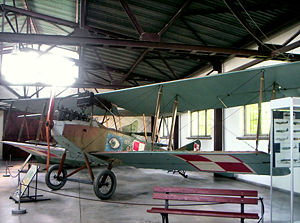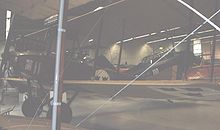Albatros B.II Video - Polish Aviation Museum, Krakow
|
|
Albatros B.II
B.II

Picture - Albatros B.II in exhibition in Polish Aviation Museum
Role: Reconnaissance aircraft
Manufacturer: Albatros Flugzeugwerke
First flight: 1914
Primary users: Germany
Sweden
Austro-Hungary
Finland
The Albatros B.II was an unarmed German two-seat reconnaissance biplane of the First World War.
Design and development
Designed by Ernst Heinkel based on his 1913 Albatros B.I, the B.II was the aircraft that brought the aircraft manufacturer Albatros Flugzeugwerke to the world's attention.
The B.II had a shorter wingspan than the B.I and used a variety of engines up to 89 kW (120 hp). In 1914 it set an altitude record of 4,500 m (14,800 ft). The seating arrangement was not ideal; the pilot occupied the rear cockpit and the observer sat in front over the wings which greatly reduced his downward view while the protruding engine block almost completely obscured the view over the nose. When Albatros developed the armed C.I based on their B-series, the seat positions were swapped so that the observer/gunner had a better view and clear field of fire.
A floatplane variant of the B.II was developed, known as the W.I or B.II-W, as was a purpose-built trainer with increased wingspan and different engines, designated the B.IIa. Further developments led to the Albatros B.III, which was produced in small numbers.
Operational history
First flying in 1914, large numbers of the B.II were built and, though it was relegated from front-line service in 1915 following the introduction of the armed C-type two-seaters, the B.II remained in service as a trainer until 1918 and was still operated by the Swedish Air Force in 1919 and by the Polish Air Force during Polish-Soviet war in 1920.
Service in Sweden

Picture - FVM-built Albatros B.IIa displayed in the Swedish Air Force Museum
In 1914, the German manufacturer Albatros-Flugzeugwerke GmbH of Berlin-Johannisthal was touring several countries in northern Europe, displaying their new aircraft, the Albatros B.IIa. At the time, it was considered one of the best primary trainer aircraft. However, the landing gear and the propeller were damaged when it arrived in Sweden. Due to the outbreak of World War I, no spares could be sent, and the aircraft was interned. It was repaired and used as a trainer in the Swedish Air Force. This aircraft was later copied and manufactured in Sweden by five different aircraft companies: Svenska Aeroplanfabriken (SAF), Sx¶dertelge Werkstx¤der (SW), Marinens Flygvx¤sende (MFV), Nordiska Aviatikbolaget (NAB) and Flygkompaniets Verkstx¤der Malmen (FVM). It was the first military trainer aircraft in Sweden and received the designation Sk 1 and x–2 in the Swedish Air Force (the two types differed slightly, mainly by choice of engine). An FVM-built Sk 1 Albatros is on public display in the Swedish Air Force Museum near Linkoping. The type was being used until 1935. One aircraft was later sold to Finland.
Service in Finland
NAB Albatros Type 9 (and SW 20 Albatros), Type 12 and Type 17 were among the first aircraft of the Finnish Air Force. It was in use between 1918 and 1923. There were two Type 9, and one each of the Type 12 and 17. Further there was one SW 20 Albatros, which was similar to Type 9.
The Type 12 aircraft was destroyed in the ferrying flight to Finland and the remains of the aircraft were found near Eckerx¶, x…land.
Operators
German Empire
Luftstreitkrx¤fte
Austria
Austro-Hungarian Imperial and Royal Aviation Troops
Finland
Finnish Air Force operated 5 aircraft postwar.
Lithuania
Lithuanian Air Force operated this type postwar.
Poland
Polish Air Force operated this type postwar.
Sweden
Swedish Air Force operated 47 aircraft postwar.
Swedish Navy operated 5 aircraft between 1920 and 1929.
Bulgaria
Bulgarian Air Force operated this type to 1918
United Kingdom
Royal Naval Air Service, Royal Flying Corps, Royal Air Force operated one aircraft from August 1914 - February 1918.
Specifications (B.II)
General characteristics
Crew: two, pilot and observer
Length: 7.63 m (25 ft 0 in)
Wingspan: 12.80 m (42 ft 0 in)
Height: 3.15 m (10 ft 4 in)
Wing area: 43 m² (463 ft²)
Loaded weight: 1,071 kg (2,361 lb)
Powerplant: 1x— Mercedes D.II 6-cylinder liquid-cooled inline engine, 75 kW (100 hp)
Performance
Maximum speed: 105 km/h (57 kn, 66 mph)
Service ceiling: 3,000 m (9,840 ft)
Related development Albatros B.I - Albatros B.III - Albatros C.III - Lebed XI - Lebed XII Comparable aircraft Hansa-Brandenburg B.I
Albatros B.II Pictures and Albatros B.II for Sale.
Living Warbirds: The best warbirds DVD series.
Source: WikiPedia